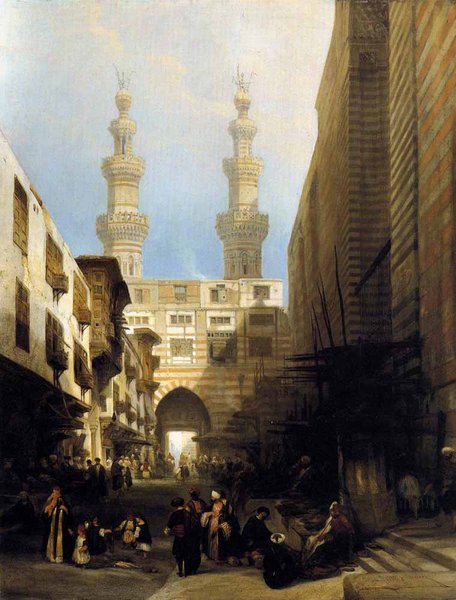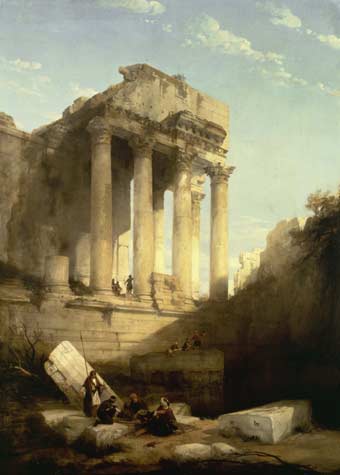David Roberts (1796 – 1864)
Get a Roberts Certificate of Authenticity for your painting or a COA for your Boucher drawing or print.
For all your Roberts artworks you need a Certificate of Authenticity in order to sell, to insure or to donate for a tax deduction.
How to get a Roberts Certificate of Authenticity is easy. Just send us photos and dimensions and tell us what you know about the origin or history of your Roberts painting, drawing or print.
If you want to sell your Roberts painting, drawing or print use our selling services. We offer Roberts selling help, selling advice, private treaty sales and full brokerage.
We have been authenticating Roberts and issuing certificates of authenticity since 2002. We are recognized Roberts experts and Roberts certified appraisers. We issue COAs and appraisals for all Roberts artworks.
Our Roberts paintings, drawings and print authentications are accepted and respected worlwide.
Each COA is backed by in-depth research and analysis authentication reports.
The Roberts certificates of authenticity we issue are based on solid, reliable and fully referenced art investigations, authentication research, analytical work and forensic studies.
We are available to examine your Roberts painting, drawing or print anywhere in the world.
You will generally receive your certificates of authenticity and authentication report within two weeks. Some complicated cases with difficult to research Roberts paintings or drawings take longer.
Our clients include Roberts collectors, investors, tax authorities, insurance adjusters, appraisers, valuers, auctioneers, Federal agencies and many law firms.
We perform David Roberts art authentication, appraisal, certificates of authenticity (COA), analysis, research, scientific tests, full art authentications. We will help you sell your David Roberts or we will sell it for you.

David Roberts, a Scottish painter, was born at Stockbridge, Edinburgh. His portrait was painted in 1840 by fellow-artist Robert Scott Lauder and was purchased in 1980 by the National Gallery of Scotland. He was apprenticed by his father, a shoemaker, for seven years to a painter and house-decorator; and during this time he employed his evenings in the study of art. In 1820 he formed the acquaintance of Clarkson Stanfield, then painting at the Pantheon, Edinburgh, at whose suggestion he sent three pictures in 1822 to the Exhibition of Works by Living Artists, held in Edinburgh.
In the same year he removed to London, where he worked for the Coburg Theatre, and was afterwards employed, along with Stanfield, at Drury Lane. In 1824 he exhibited at the British Institution a view of Dryburgh Abbey, and sent two works to the first exhibition of the Society of British Artists, of which he was elected president in 1831. In the same autumn he visited Normandy, and the works which were the results of this excursion began to lay the foundation of the artists reputation, one of them, a view of Rouen Cathedral, being sold for eighty guineas. His scenes for an opera, The Seraglio, executed two years later, and the scenery for a pantomime dealing with the naval victory of Navarino, and two panoramas executed jointly by him and Stanfield, were among his last work for the theatres.

In 1829 he exhibited the “Departure of the Israelites from Egypt”, in which his style first becomes apparent; three years afterwards he travelled in Spain and Tangiers, returning in the end of 1833 with a supply of effective sketches, elaborated into attractive and popular paintings. His “Interior of Seville Cathedral” was exhibited in the British Institution in 1834, and sold for £300; and he executed a fine series of Spanish illustrations for the Landscape Annual of 1836, while in 1837 a selection of his Picturesque Sketches in Spain was reproduced by lithography.
It was J.M.W. Turner, who managed to persuade him to abandon scene painting and devote himself to becoming a true artist. Set sail for Egypt on 31 August 1838 with the intention of producing drawings that he could later use as the basis for the paintings and lithographs to sell to the public. Egypt was very much in vogue at this time, and travelers, collectors and lovers of antiquities were very keen to buy works depicting the great monuments of ancient Egypt or inspired by the East.

Roberts arrived in Egypt in 1838, a few years after Owen Jones. He was a prolific artist and executed hundreds of drawings and watercolors during his travels in Egypt and the near East, which, on his return to London, were made into lithographs by Louis Haghe and published in several volumes. He was received by the Muhammad Ali Pasha in Alexandria on 16 of May 1839, shortly before his return to Britain.
In 1838 Roberts made a long tour in the East, and accumulated a vast collection of sketches of a class of scenery which had hitherto been hardly touched by British artists, and which appealed to the public with all the charm of novelty. The next ten years of his life were mainly spent in elaborating these materials. An extensive series of drawings was lithographed by Louis Haghe in Sketches in the Holy Land and Syria, 1842-1849.

In 1851, and again in 1853, Roberts visited Italy, painting the “Ducal Palace, Venice”, bought by Lord Londesborough, the “Interior of the Basilica of St Peters, Rome, Christmas Day, 1853”, and “Rome from the Convent of St Onofrio”, presented to the Royal Scottish Academy.
His last volume of illustrations, Italy, Classical, Historical and Picturesque, was published in 1859. He also executed, by command of Queen Victoria, a picture of the opening of the Great Exhibition of 1851. In. 1839 he was elected an associate and in 1841 a full member of the Royal Academy; and in 1858 he was presented with the freedom of the city of Edinburgh. The last years of his life were occupied with a series of views of London from the Thames. He had executed six of these, and was at work upon a picture of St Paul’s Cathedral, when he died suddenly of apoplexy.

Still wondering about a painting in your family collection? Contact us…it could be by David Roberts.
Reviews
1,217 global ratings
5 Star
4 Star
3 Star
2 Star
1 Star
Your evaluation is very important to us. Thank you.
